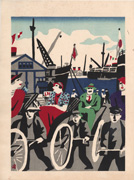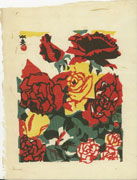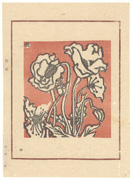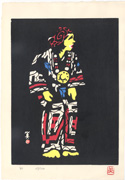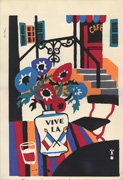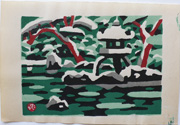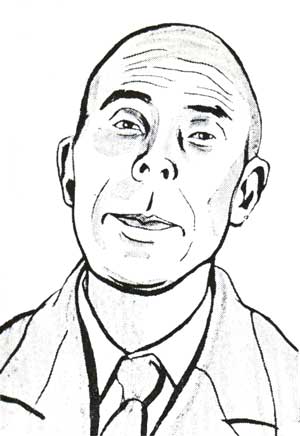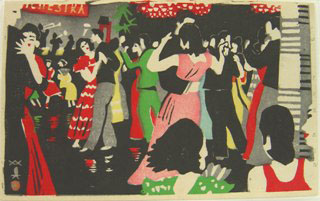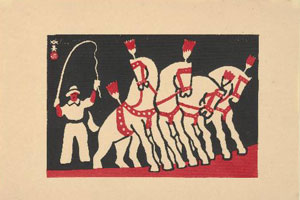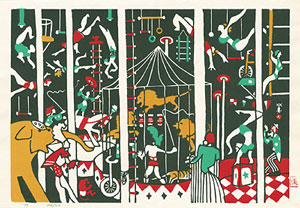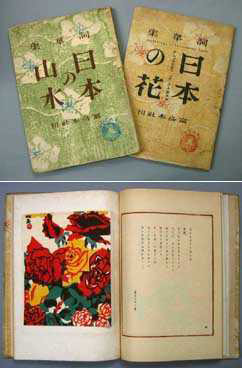Prints in Collection
| IHL Cat. #2149 | Poppies from the book Nihon no Hana, 1946 IHL Ct. #1214 |
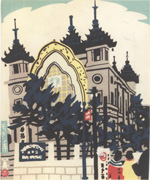 Modan-dera, No. 66 from the series One Hundred Scenes of Kobe, 1952-1953 IHL Cat. #1262 | Ainu Woman, 1980 (orig. 1962) IHL Cat. #2308 | Vive La, 1980 IHL Cat. #1958 |
 Photo of the artist Photo of the artistc. 1940. | Kawanishi Hide was born on July 9, 1894 in the port city of Kobe, where he lived all his life. Inspired by Yamamoto Kanae's (1882-1946) creative prints (sosaku hanga), which Kanae carved and printed himself, he taught himself to carve and print while still in high school. “I first got excited about woodcuts when I saw Kanae Yamamoto’s print A Small Bay in Brittany in the window of an art shop in Osaka. I’d seen ukiyo-e, of course, but they didn’t interest me. Yamamoto’s print did, and I started to make a few prints along with my oils.”2 (Along with Yamamoto the artist also sites Lautrec, Van Gogh, Onchi and Gaugin as having direct influence on his work.)3 Graduating from Kobe business school in 1915, Kawanishi showed no interest in his family’s shipping business. To his father’s chagrin, he chose to resurrect the family’s hereditary postal job knowing that it would allow him time to create prints. Despite his isolation from the center of the sosaku hanga movement in Tokyo, Kawanishi was a core member of the movement. He first exhibited prints with the Nihon Sosaku-Kiyokai (Creative Print Association) in 1923, which he joined in 1932, and starting in 1931, he exhibited with Kokugakai (National Painting Association) which he joined in 1935. Kawanishi contributed to several |
Dance Hall, 1935
In 1952-1953 he created the series Kobe Hyakkei (One Hundred Scenes of Kobe), "poster color drawings of the changing city after the World War." (See IHL Cat. #1262.)
Another popular subject of Kawanishi’s prints is the circus. The artist tells the story of asking the manager of a visiting German circus for one of their advertising posters and being given an entire set of posters.7 It's easy to imagine these posters displaying the flat simplified shapes of Art Deco posters of the period, a style that Kawanishi adopted, as shown below.
In creating his prints, Kawanishi used solid blocks of katsura or ho, and printed on thick hodomura paper, thoroughly moistened so that the colors seep through to the back.8
Kawanishi was a prolific artist, creating some 1,000 designs during his lifetime and producing and contributing to a number of printed albums and books including the book Nihon no hana (Flowers of Japan) in which the print Rose in this collection originally appeared.
Nihon no hana
Kawanishi was awarded the Hyogo Prefecture Culture Prize in 1949 and Kobe Shinbun Peace Prize9 in 1962. His work is contained in many major museum collections including those of the British Museum; Carnegie Museum of Art; Honolulu Academy of Arts; Museum of Fine Arts, Boston; Fine Arts Museums of San Francisco; The National Museum of Modern Art, Kyoto.
His third son Kawanishi Yuzaburō 川西祐三郎 (1923-2014) works much in his father's style but with more international subjects.
Sample Seals of the Artist
 Stylized 英 Hide / Hide ひで in kana |  Hide ひで in kana |  Hide ひで in kana |  Hide ひで in kana |  Hide 英 - found stamped in the margin on posthumous prints issued in 1979/1980 by Keishōsha |
1 Modern Japanese Woodblock Prints: An Art Reborn, by Oliver Statler, Charles E. Tuttle Co., 1956, p. 115.
2 Guide to Modern Japanese Woodblock Prints: 1900-1975, Helen Merritt, University of Hawaii Press, 1992, p. 61.
3 Modern Japanese Prints: An Art Reborn, Oliver Statler, Charles E. Tuttle Company, 1956, p. 118.
4 Images of a Changing World: Japanese Prints of the Twentieth Century, Donald Jenkins, Portland Art Museum, 1983, p. 88.
5 Modern Japanese Woodblock Prints - The Early Years, Helen Merritt, University of Hawaii Press, 1998, p. 230.
6 Statler, p. 116.
7 Ibid.
8 Ibid. p. 118.
9 The Kobe Shimbun, a daily newspaper in Kobe, Japan, established the Peace Award in 1947 to commemorate the promulgation of the Peace Constitution of Japan.
8 Ibid. p. 118.
9 The Kobe Shimbun, a daily newspaper in Kobe, Japan, established the Peace Award in 1947 to commemorate the promulgation of the Peace Constitution of Japan.
last updated:
6/26/2020
8/2/18
